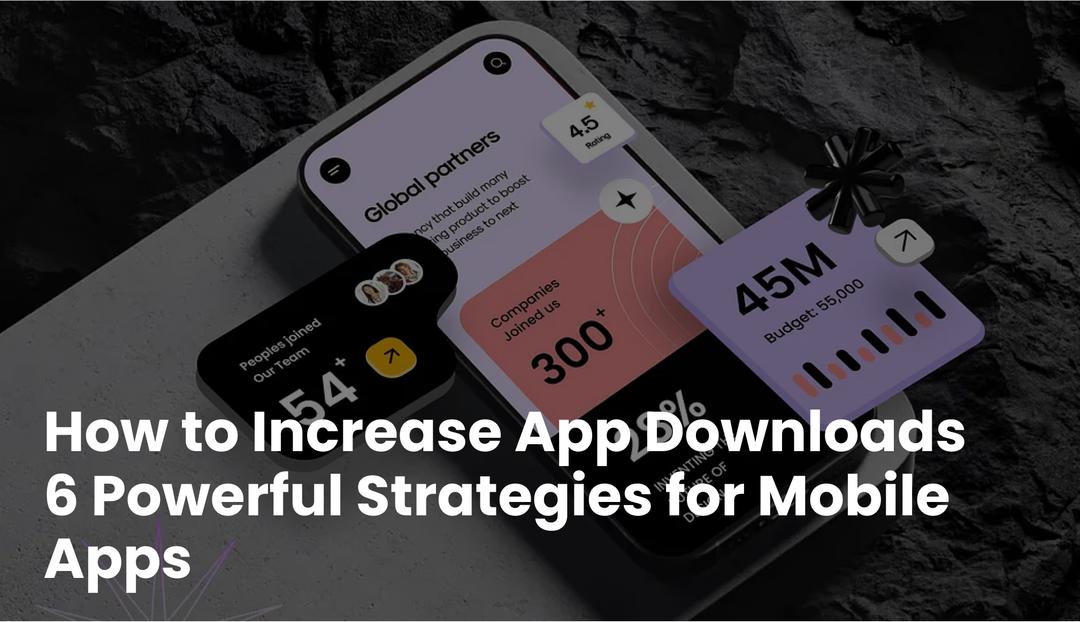Are you searching for the ways to use agile sprints and growth loops for android app development? You are in the right place. In today’s fast-moving digital world, users expect fast, smooth, and user-friendly mobile apps. But how do you build such an app, especially on a competitive platform like Android?
There are two strategies that stand out for building successful Android apps: Agile sprints and growth loops.
Let’s break down how these powerful approaches can help you build, improve, and scale your app step by step.
What Are Agile Sprints?
Agile plays a key role in mobile app development, and Scrum is one of the most widely used frameworks under it. Originally used for small projects, Scrum has quickly proven effective for handling large, complex app development tasks by breaking them down into manageable parts.
When building mobile apps, mobile app developers on DesignRush face unique challenges, like small screen sizes, limited memory, and lower processing power. That’s why Agile and Scrum are a great fit. They allow teams to plan, build, test, and manage the app development process in smaller chunks, making it more flexible and efficient.
Build Smarter with Agile Sprints
Want a faster, more flexible mobile app development process? Our Scrum-based Agile approach helps break down complex projects into manageable sprints for better results.
Start Your Project Today
As a trusted android app development company, BitsWits uses sprints, short 2-week development cycles where our team focuses on a set of tasks from the product backlog. At the end of each sprint, we deliver a working version of the app, collect feedback, and keep improving it in the next cycle.
Each sprint runs for about 2 to 4 weeks, and we follow a proven Agile process that keeps your app development efficient, transparent, and goal-driven.
Next, let’s take a closer look at the Agile methodology steps we follow at BitsWits for successful mobile app development.

1. Scrum Roles:
Who Does What in an Agile Team? Running a successful Agile team depends a lot on how well the roles are defined and managed. Each person in the scrum process has a clear responsibility that helps keep the project on track and moving forward.
Product Owner
The Product Owner acts as the bridge between the customer and the development team. They are in charge of deciding what the team should work on and making sure the tasks (known as the product backlog) are always up to date and properly prioritized. Their job is to ensure the team is building the right features that deliver the most value to the user.
Their responsibilities:
- Managing and updating the product backlog
- Setting task priorities based on business needs
- Ensuring clear communication between stakeholders and the team
Scrum Master
The Scrum Master is like the coach of the team. They make sure the team follows Agile principles and Scrum practices correctly. If there are roadblocks or issues slowing down the team, the Scrum Master steps in to help resolve them.
Their responsibilities:
- Guiding the team in using Agile the right way
- Helping remove any obstacles that affect productivity
- Monitoring team progress and performance
Scrum Team
The Scrum Team is the group of people who actually do the work—this includes developers, testers, designers, and other specialists. They are self-organized, which means they decide how to get the work done without needing constant supervision. They’re also cross-functional, meaning they have all the skills needed to complete the project from start to finish.
Their responsibilities:
- Designing, developing, and testing the app
- Collaborating closely to deliver working features
- Managing their own workload within each sprint
2. Product Backlog – The To-Do List That Drives the Project
The Product Backlog is a prioritized list of all the features, fixes, improvements, and technical tasks that need to be done to complete the mobile app. It’s managed by the Product Owner and constantly updated as the project evolves.
Before each sprint begins, the team reviews the backlog to decide which tasks to work on during that cycle. This helps everyone stay focused on what matters most right now without getting overwhelmed by everything that needs to be done later.
What the Product Backlog Includes:
- User stories (features written from the user’s perspective)
- Bug fixes or system improvements
- Technical tasks and documentation
- Priority levels and deadlines for each item
The goal is to always have a well-prepared, updated backlog before the team starts the sprint. This ensures that development runs smoothly and there’s no confusion about what needs to be done.
3. Sprint Backlog & Planning
At the start of every sprint, the development team at BitsWits sits down to decide which tasks from the product backlog they will focus on in the current sprint. This list of selected tasks is called the sprint backlog.
The sprint backlog includes clear, actionable items that the team agrees to complete within the sprint timeline. Once everything is set, the sprint begins.
4. Daily Scrum Meeting
Once the sprint starts, the team holds a daily stand-up meeting, called the Daily Scrum. This meeting is short, usually just 15 minutes, and helps the team stay aligned.
Each team member quickly shares:
- What they worked on yesterday
- What they plan to work on today
- Any challenges or blockers they’re facing
These check-ins keep everyone informed and help the project move forward smoothly.
5. Sprint Review, Show and Share Progress
At the end of the sprint, the team presents their completed work to stakeholders during a Sprint Review. This is where they show what they’ve built, explain what went well, and discuss any issues they faced.
The feedback received here helps guide the next sprint. In other words, what the team learns in one sprint shapes the plan for the next.
6. Increment
The final output of each sprint is called an increment. It’s a working part of the mobile app that’s complete, functional, and meets all quality standards.
Each increment should be ready for use or launch, even if it’s just a small part of the full app. This ensures continuous progress and fast delivery.
7. Learn. Respect. Improve
After each sprint, the cycle starts again. The team chooses new tasks from the product backlog for the next sprint. At the same time, the Product Owner ensures that the highest-priority items are ready to be tackled next.
This short, repeating process gives the team plenty of chances to learn from feedback, improve their work, and grow stronger with each sprint.
Why Agile Is the Best Choice for Mobile App Development
Unlike desktop applications that can go years without needing major updates, mobile apps must be fast, flexible, and constantly evolving. User expectations change quickly, whether it’s a new feature, a design upgrade, or a quick fix, app owners need to be ready to adapt at any moment. This is where the Agile approach fits perfectly.
Agile allows mobile apps to be built step by step, with continuous improvements based on real user feedback. It helps avoid costly rework by encouraging early and frequent testing, making it easier to spot and fix issues before they grow. Most importantly, it allows developers to release updates quickly, keeping the app relevant and competitive in a fast-paced market.

As an android app development company for startups on DesignRush, we use Agile to ensure every mobile app we build is high-quality, user-friendly, and ready for the future without unnecessary delays or revisions.
1. Better App Quality
With Agile, testing isn’t left until the end. Instead, quality checks happen in every sprint. This means the app is reviewed and improved at each step, helping ensure it meets all the quality standards from day one. As a result, the final product is more stable, high-performing, and ready for users.
2. Higher Client Satisfaction
Agile is built around client involvement. After every sprint, clients get a demo of the new features that were added. This regular feedback loop keeps everyone on the same page and gives clients more confidence in how the app is progressing.
3. More Transparency
Everyone involved developers, designers, testers, and clients, stays in the loop. With Agile, there’s full visibility into what’s being worked on, what’s completed, and what’s next. This openness makes the entire process clearer, smoother, and more accountable.
4. Faster Return on Investment (ROI)
One of the biggest advantages of Agile is speed. The development process starts quickly, and multiple parts of the project can be handled at the same time. Since features are built and tested in smaller parts, the team can move faster and deliver results sooner leading to quicker returns on your investment.
5. Easy and Fast Changes
Agile is designed for change. If you need to tweak a feature or add something new, the team can easily adjust plans in the next sprint, without affecting the overall timeline or blowing the budget. This flexibility makes Agile perfect for fast-moving industries and evolving user needs.
Factors to Consider Before Choosing Agile for Mobile App Development
While Agile offers flexibility, speed, and high-quality outcomes, it’s important to understand that it’s not a one-size-fits-all solution. For Agile to work effectively, you need the right mindset, resources, and structure in place.

Here are the most important factors to think about before you implement Agile in your mobile android app development process:
1. Team Readiness and Mindset
Agile is a collaborative and fast-paced approach. Your team needs to be comfortable working in short development cycles (sprints), with frequent reviews, quick changes, and constant communication.
- Is your team experienced or trained in Agile and Scrum practices?
- Are they open to regular feedback, flexible planning, and self-organization?
- Can your team members take ownership of tasks and adapt quickly?
If the answer is yes, you’re already on the right path, get linked with the Startup app developers at BitsWits and start the process ASAP.
2. Client Involvement and Availability
Agile thrives on regular client input. After every sprint, clients should be available to review the progress, provide feedback, and approve or suggest changes.
Before adopting Agile, make sure:
- Your client is willing to be actively involved throughout the project.
- They are available for sprint planning, reviews, and quick decision-making.
- They understand that their feedback directly shapes the final product.
Without client engagement, the key advantage of Agile, building the right product for the user is lost.
3. Clear and Evolving Product Vision
Agile works best when you have a clear product goal, even if the specific features are still evolving. You don’t need to plan everything in advance, but you do need a solid direction.
Consider:
- Do you have a clear understanding of your app’s purpose, target users, and core features?
- Are you open to adjusting features and priorities based on real-time feedback and user behavior?
If your product vision is too vague or changes too frequently without reason, it can derail the Agile process.
4. Effective Communication Tools and Culture
Agile development relies on constant communication within the team and with stakeholders. Whether your team is in-house or remote, you need tools and systems in place to support this
You’ll need:
- Project management tools like Jira, Trello, ClickUp, or Asana
- Communication channels like Slack, Microsoft Teams, or Zoom
- Shared access to sprint backlogs, roadmaps, and documentation
More importantly, your team culture should support open communication, active listening, and collaboration.
5. Time and Budget Flexibility
Agile doesn’t promise fixed timelines or costs, it focuses on delivering the most valuable features first, improving them over time, and staying flexible to change.
This means:
- Your budget and timeline should allow for iterative releases
- You’re comfortable with regular reviews, changes, and refinements
- You understand that Agile provides value faster, even if the entire app takes several sprints
- Clients and product owners need to be flexible and see Agile as a long-term investment, not just a one-off build.
6. Defined Roles and Responsibilities
Agile teams work best when everyone knows their role. This includes having:
- A Product Owner who manages the backlog and sets priorities
- A Scrum Master who ensures the process runs smoothly
- A Development Team that handles coding, testing, and delivery
Before adopting Agile, make sure you’ve assigned these roles clearly and that everyone understands what’s expected of them.
7. Willingness to Embrace Change
Finally, Agile is all about continuous improvement. It encourages teams to learn from every sprint and use those lessons to improve the next one. If your team or leadership prefers rigid planning and doesn’t adapt well to change, Agile might not be the right fit.
But if you value flexibility, collaboration, and constant growth. Agile can transform the way you build and deliver mobile apps.
The Sprint Cycle: How It Works

Here’s how a typical Agile sprint looks in Android app development:
Plan: Decide what to build in the next sprint (e.g., user login feature).
Design: Create UI/UX wireframes and workflows.
Develop: Build the feature and write the code.
Test: Run QA to catch bugs and fix them.
Review: Demo the feature and gather feedback.
Deploy: Release to users or internal teams.
Reflect: Hold a retrospective—what worked and what needs improving?
Which Agile Principles Are Considered Most Important at BitsWits?
Among the 12 official Agile principles, here are the ones we value most in our mobile android app development process:
1. Customer Satisfaction Through Continuous Delivery
We believe in delivering usable app features frequently, every 2 to 4 weeks so our clients always see progress and get early value from their investment.
2. Welcome Change, Even Late in the Process
Change is a part of building great apps. Whether it’s new user feedback or a market shift, we’re always ready to adjust our plans and build what really matters.
3. Work Together Daily
Our developers, designers, testers, and project managers work closely every day. This strong teamwork ensures smooth communication and fast decision-making.
4. Build Projects Around Motivated Individuals
We trust our team. Every developer at BitsWits is empowered to make decisions, take ownership, and innovate. That’s how we deliver better products, faster.
5. Simplicity Is Key
We focus on building just what’s needed—no overcomplication. This keeps our code clean, the app lightweight, and the process efficient.
6. Continuous Attention to Technical Excellence
From clean code to rigorous testing, we prioritize quality at every step. A strong foundation means fewer bugs, better performance, and smoother scaling later.
7. Reflect and Adjust Regularly
After every sprint, we review what worked and what didn’t. We use this insight to improve our process, team dynamics, and final product quality.
Experience Agile the BitsWits Way
We don’t just build apps — we evolve with your vision. Our Agile principles ensure fast delivery, continuous improvement, and a product that truly fits your needs.
Consult Our Experts
Conclusion
Agile sprints and growth loops offer a smart, flexible approach to Android app development. By breaking the project into smaller, manageable parts, teams can deliver working features faster, get real-time feedback, and improve the app continuously.
At BitsWits, we follow Agile best practices to keep the process transparent, efficient, and client-focused. Each sprint brings us closer to building an app that performs well, engages users, and adapts quickly to market changes.
If you’re looking to develop a high-quality Android app with speed, clarity, and long-term success in mind, Agile is the way forward, and we’re ready to make it happen.
FAQs












